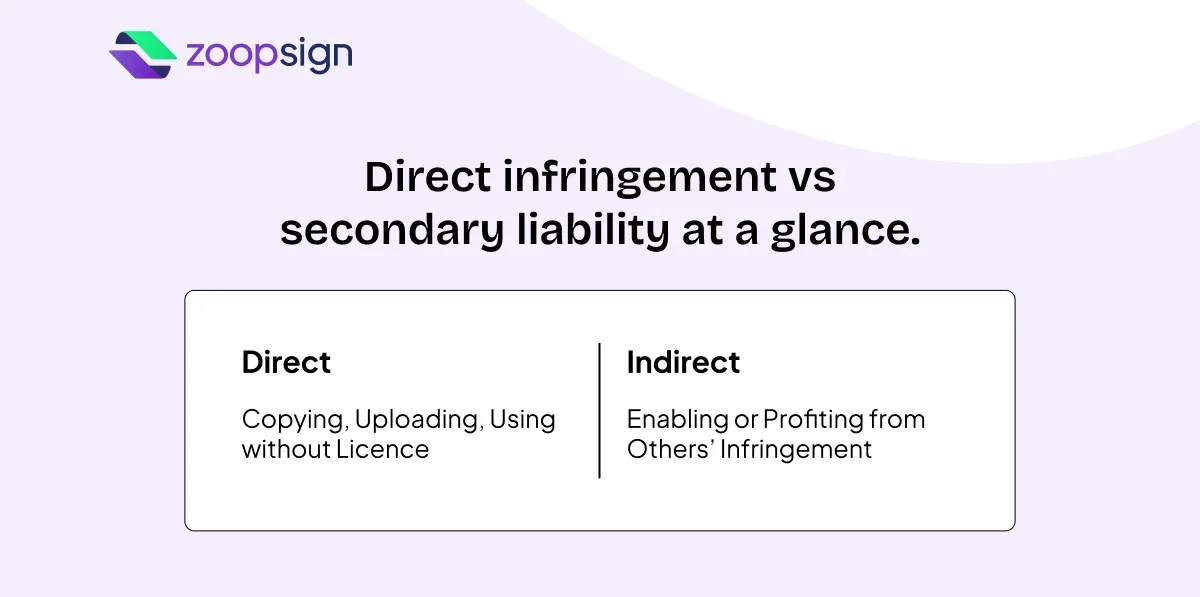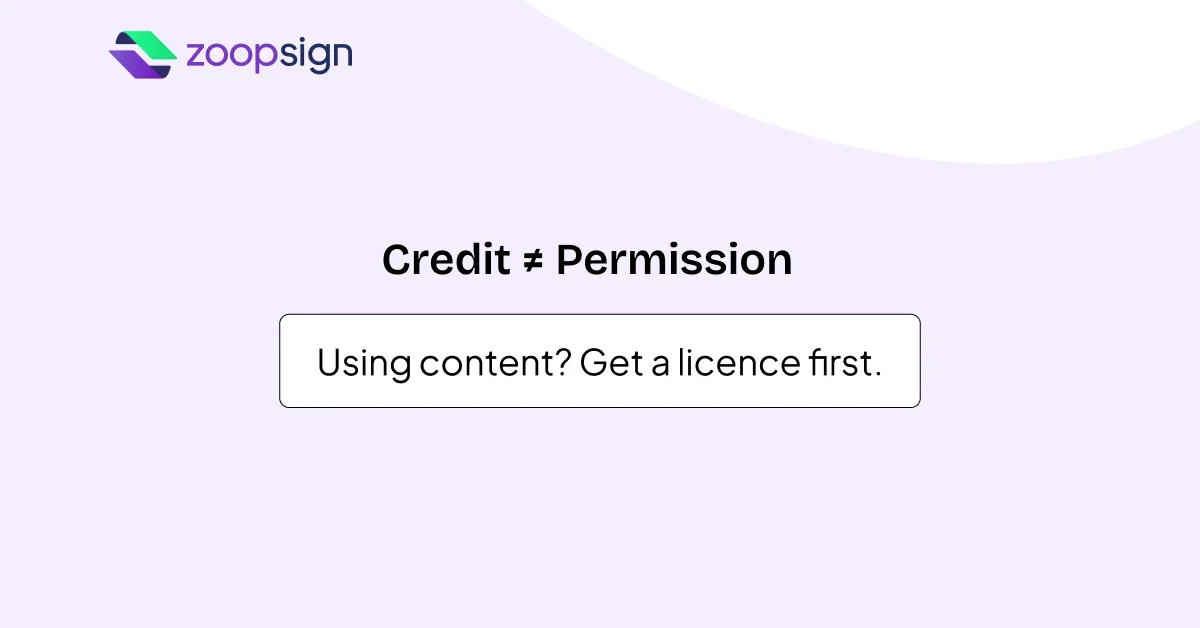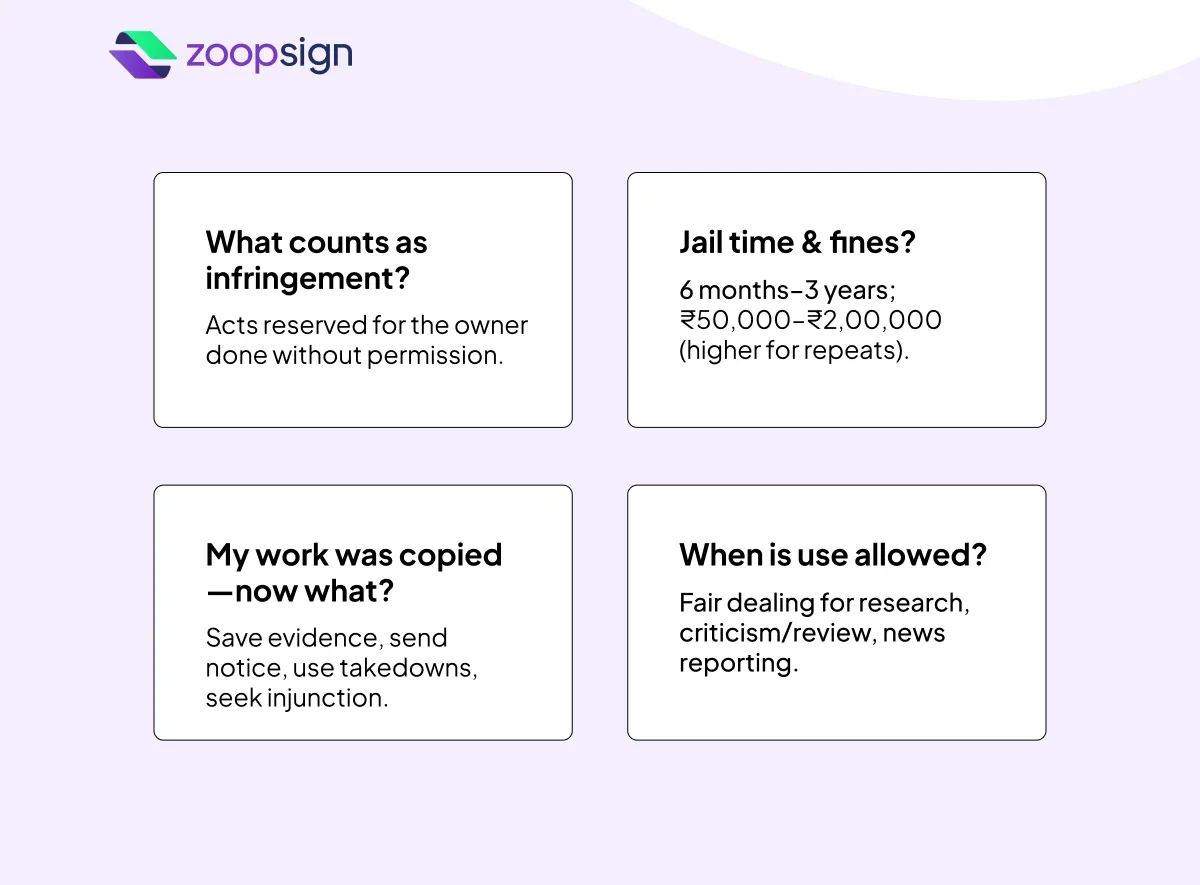If you’ve ever had a reel muted because of a song, or spotted your content or image post copied and pasted on someone else’s site, you know the sinking feeling: “Wait… is this copyright stuff serious?”
To answer simply: yes.
Creators want credit (and control), businesses want clarity, and everyone wants to avoid messy legal fights.
Keep reading this page for all the details you NEED to know about Copyright Infringement. Let’s discuss what counts as infringement, why courts care, the penalties (yep, jail time is possible), a few Indian cases you can name-drop, and practical playbooks for creators and SMEs.
Keep reading!
Who is this for?
- Solo creators, agencies, startups, SMEs, and anyone who publishes content, ships software, makes videos, sells products, or runs campaigns in India.
- If “content” or “code” sits anywhere in your workflow, this is you.
What is Copyright Infringement?
Copyright is a bundle of exclusive rights the law gives creators over their original work, like the right to copy, distribute, perform, display, communicate to the public, or adapt it. Infringement occurs when someone (without permission or a valid exception) performs any of those actions.
In India, Section 51 of the Copyright Act, 1957, lays out when infringement occurs, including when a person permits a place (offline or online) for infringing communication to the public for profit, or deals in infringing copies.
What’s protected? It’s actually more than just books and songs. Indian law covers literary, artistic, and musical works, cinematograph films, sound recordings, and software (computer programs, databases). Protection arises automatically when an original work is created and fixed; registration helps but isn’t required to own copyright.
Everyday examples that are infringement (no licence = risky):
- Copy-pasting a competitor’s long-form blog or resource page into your site.
- Uploading a ripped movie or reposting a TV episode to social.
- Using a trending song in an advertisement without a proper licence.
- Shipping a product using cracked or unlicensed software
- Running a platform or event that knowingly plays or hosts unlicensed music/video.
Not every copy is illegal. India recognizes fair dealing (Section 52) for limited purposes like private use/research, criticism/review, and reporting current events. Use it carefully: context, amount used, and market impact matter.
What Are the Types and Examples of Copyright Infringement?
Infringement can be direct (actual copying or unauthorized use) or indirect (aiding, abetting, or distributing pirated copies).
Here’s to add more in detail on this:
1. Direct infringement
This is the “you did the act yourself” scenario - copying, uploading, distributing, performing, or adapting the work without permission.
Examples: copying a film’s script, distributing pirated software inside a company, or using a popular song in a commercial without a sync licence.
2. Indirect/secondary infringement
Here, you enable, profit from, or ignore infringement by others. Indian courts recognize secondary liability for things where you permit a place/platform for infringing communication for profit, or trade in infringing copies.
Think: a marketplace that lets vendors sell pirated content, or a platform that ignores specific, valid notices about infringing uploads. Also, Indian courts have refined how far platform liability goes (more under cases).
Real-life SME scenarios:
- Website revamp that “borrows” another brand’s layouts, copy, and images.
- Internal use of unlicensed fonts or stock photos beyond the allowed scope.
- Team members installing unlicensed tools (“we’ll regularise later”).
- Sharing copyrighted music in a store/restaurant without a public performance licence.
What Are the Legal Consequences and Penalties?
There are two tracks: civil (to stop and compensate) and criminal (to punish). Many matters start with notices/takedowns and only some escalate to court.
1. Civil (Section 55) what courts can order
- Injunctions (including urgent interim orders) to stop the use or release.
- Damages (compensation) or account of profits (hand over profit earned).
- Delivery/destruction of infringing stock and recovery of legal costs (discretionary).
If a defendant shows they didn’t know the work was protected, courts may limit remedies (e.g., injunction + profits rather than heavy damages). Still, that’s a narrow escape and not something to bank on.
2. Criminal (Chapter XIII) how serious can it get?
Indian law allows criminal prosecution in addition to civil suits.
Police can seize infringing copies without a warrant when they believe a §63 offence has occurred (must be produced before a Magistrate). Practically, this matters in raids on large-scale piracy or unlicensed software usage.
Several consumer-facing explainers summarise these ranges similarly (good to share internally with teams).
Bottom line: Courts can stop you fast (injunction), make you pay (damages/profits), and in egregious or repeated cases, send you to jail. Don’t let “but we credited the artist” be your compliance plan.
For businesses, building digital-first documentation and licensing workflows isn’t just about efficiency; it’s also proof of compliance in disputes. Tools that embed eSignatures, eStamps, and audit trails directly into contracts can reduce legal exposure if copyright is challenged later.
What Are Landmark Copyright Infringement Cases in India?
Some landmark Indian copyright cases are R.G. Anand v. Deluxe Films, Eastern Book Company v. D.B. Modak, and Super Cassettes v. MySpace regularly shape how courts view originality, fair use, and digital infringement.
But here are a few more cases in detail:
1. Hawkins Cookers Ltd vs Magicook Appliances (Delhi HC)
Hawkins’ labels and cookbooks were copied for competing pressure cookers. The court granted a permanent injunction and monetary relief (including accounts of profits), reinforcing that creative labels and cookbooks are protectable works. It’s frequently cited in disputes involving packaging and manuals.
2. Yash Raj Films vs Sri Sai Ganesh Productions (Delhi HC, 2019)
The court found the Telugu film “Jabardasth” substantially copied the plot, characters, and expressive elements of “Band Baaja Baaraat.” Result: injunction and relief in favour of YRF classic reminder that expression (not just ideas) is protected.
3. Super Cassettes (T-Series) vs Online Platforms (YouTube/MySpace)
Indian courts have ordered takedowns and clarified intermediary duties. In the MySpace appeals context, the Delhi High Court moved towards a notice-and-action standard - platforms aren’t required to pre-screen everything, but must act when given specific knowledge of infringing content. This shapes how Indian platforms handle copyright notices.
Why these cases matter to you: courts protect labels and manuals (Hawkins), narrative expression in films (YRF), and expect platforms/businesses to act quickly on specific notices (MySpace line). These principles apply across media from packaging to scripts to UGC platforms.
Read Blog: How to Write a Contract Addendum with E-Signature Benefits
How Can Creators Enforce Their Copyright?
Creators can enforce copyright by sending legal notices, filing civil suits for injunctions and damages, or pursuing criminal action against infringers. Registering your work makes enforcement easier, but even unregistered works are protected under law.
Here’s a little breakdown:
- Freeze the evidence: Save originals, drafts, timestamps, Git logs, emails, registration certificates (if you have them), URLs, and screenshots. Consider a quick notarised affidavit if timing will matter. (You’ll thank yourself later.)
- Send a cease-and-desist: A crisp notice often fixes honest mistakes. If the infringement is online, use the platform’s notice-and-takedown flow in parallel speed matters.
- Seek an injunction: If a launch, broadcast, or release is imminent, ask your lawyer about urgent interim relief. Courts in India routinely grant interim injunctions in clear-cut cases.
- Sue for damages/account of profits: Once the use is stopped, quantify harm. Depending on the facts, courts may award damages or require the defendant to hand over profits.
- Consider criminal action for egregious/repeat cases: Especially for piracy rings or repeat offenders: §63/63A/63B are in play; law enforcement can seize infringing stock.
- Register (even now) to strengthen your hand: Registration isn’t mandatory to own copyright, but it’s useful evidence in court and makes enforcement smoother; the Copyright Office portal simplifies the process.
Pro tip for founders/marketing leads: Add “copyright clearance” to your pre-launch checklist the same way you already check brand names and domains.
Alongside registration, digitising agreements and storing time-stamped, tamper-proof copies of creative assets ensures you have clear, admissible evidence when enforcing rights.
How to Avoid Copyright Infringement?
Always create original content, seek licenses or permissions when using others’ work, and rely on public domain or open-licensed resources when in doubt. Giving proper credit helps, but permission is the real safeguard against infringement.
Here’s something to keep in mind:
For creators & teams
- Use original or licensed content only. Keep licences, purchase orders, and emails in a central folder your team can find.
- Credit is nice, not a licence. Adding “credits: @artist” doesn’t cure infringement.
- Be careful with “free” assets. Read the scope (commercial use? modifications? redistribution?) before you download.
- Fair dealing ≠ free-for-all. If you’re quoting or commenting, use only what’s necessary, add your own analysis, and cite sources.
For SMEs & startups (what actually works):
- Asset audit & policy: List every third-party asset (images, fonts, tracks, footage, datasets, code). Write a one-pager SOP: how to source, who reviews, where to store proof.
- Software compliance: Ban cracked tools; run quarterly audits; keep licence keys in a vault. Note that knowing use of an infringing computer program can be a criminal offence (§63B).
- Marketing guardrails: Pre-clear ads/videos for music, footage, and stock usage. If in doubt, swap to a library track or commission original.
- Platform playbooks: If you host user content, have a notice-and-action workflow with SLAs. You’ll preserve safe-harbour-like protections when you act promptly on specific notices.
Copy-paste checklist:
- We only use original/licensed content (images, audio, video, copy, code).
- We keep a licence vault (POs, invoices, emails).
- Team trained on fair dealing basics; we don’t rely on “credit = permission.”
- All software is properly licensed; quarterly internal audit scheduled.
- Cease-and-desist and takedown templates ready; response owner assigned.
- Key works (codebase, scripts, brand assets, courses, music) registered for evidentiary strength.
FAQs on Copyright Infringement
Q: What acts constitute copyright infringement in India?
A: Doing anything reserved to the owner copying, distributing, communicating/performing publicly, adapting without permission is infringement. It also covers permitting a place for infringing communication for profit, or dealing in infringing copies.
Q: What are the possible penalties and jail time for infringement?
A: Civil courts can order injunctions, damages, account of profits, and deliver up infringing copies (Section 55). Criminally, §63 prescribes 6 months–3 years and ₹50,000–₹2,00,000 (first conviction), §63A increases minimums for repeat offences, and §63B targets knowing use of pirated software (7 days–3 years; fines up to ₹2,00,000). Police can seize infringing stock.
Q: What should I do if my work is infringed?
A: Save evidence, send a cease-and-desist, use platform takedowns, and if needed, file for an injunction and damages. For egregious or repeated violations, explore criminal complaints where appropriate. Registration (even post-creation) makes injunctions easier because it’s prima facie evidence.
Q: Are there exceptions where copyrighted works can be used without permission?
A: Yes. Fair dealing allows limited use for private use/research, criticism/review, and reporting current events, among others (Section 52). Apply it narrowly; don’t undermine the market for the original work.
Q: How can businesses and creators safely use copyrighted content?
A: Adopt a licensing workflow (who sources, who clears, where proof lives), run software licence audits, train teams on fair dealing, and set up a notice-and-action process if you host UGC. These aren’t just “legal” tasks they reduce campaign delays and reputation risk.


